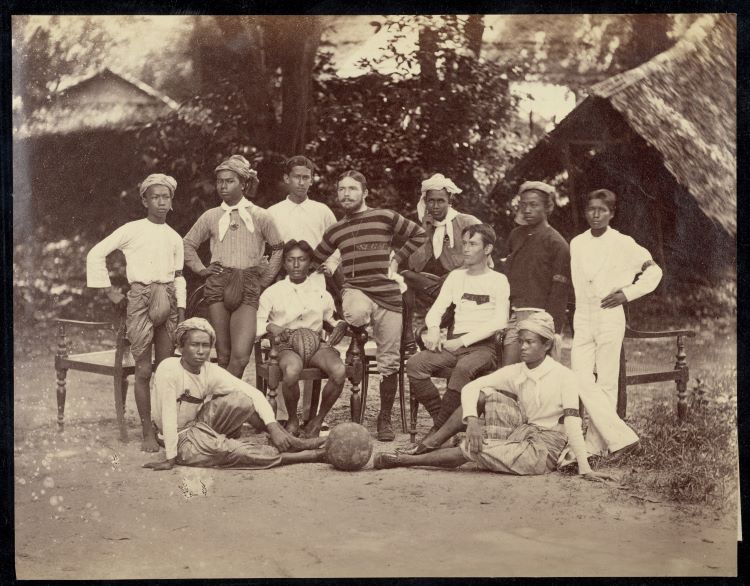
Archives and Modern Manuscripts Image of the Month: Football in Burma

In the papers of Sir James George Scott there are a few photographs, including one of a football team featuring a mix of Burmese and British players taken in Rangoon around 1879.
Scott, in the striped jersey, was at the time a teacher at St John’s College, an Anglican Mission school who had come to the region initially as a journalist. Keen to stay in a country he grew to love, when his newspaper assignment ended he joined the staff of the school. Always a keen sportsman, Scott introduced the game of football to his pupils who took to it enthusiastically. Letters written to Scott from students whilst away from the school show their love for the game. One letter stated that ‘I dreamed a beautiful dream last night. I was playing a football match with you, Sir, and it was like heaven.’ Whilst Harry Hpo Min, seen in the photograph to Scott’s left and a talented goalkeeper, wrote ‘I hope you will not play the football with any club before we come back. It is a wonderful thing.’1
Football soon spread to the wider population of Rangoon. The Burmese already played chinlone, which features players passing a wicker ball between themselves in the air without using their hands, and this no doubt enabled the locals to soon become adept at the game.
Hotly contested matches were organised between the ‘trousers’ (Europeans) and the ‘putsoes’ (a putso being a type of sarong worn by the Burmese). In one such game the Burmese scored two quick goals and restricted the Europeans to one in reply. Scott described the action: ‘ten minutes before time was called, the Europeans left their goal to look after itself and crowded forward to the attack in the hope of equalising matters, but luck was against them; shot after shot just shaved the posts on the wrong side, one rebounded off the bar, while several others were stopped by the really splendid play of the Burman goalkeeper, Harry Hpo Min. The Burmans managed to play out time without another goal being scored against them, leaving them the victors, a result which produced a scene of the wildest excitement.’2
Football soon became widely popular throughout Burma, with the Burmese helping to spread the game across the Far East. Scott himself stayed in the region off and on until 1910, holding a number of important posts for the colonial administration and becoming an authority on the indigenous tribes, their languages and customs.
There is a catalogue of the Scott collection available on ArchiveSearch at: https://archivesearch.lib.cam.ac.uk/repositories/2/resources/13396
